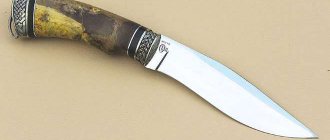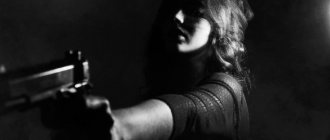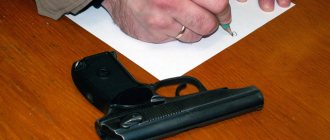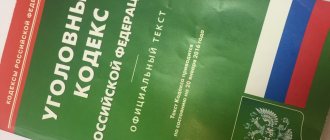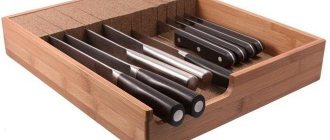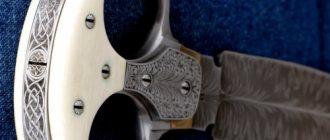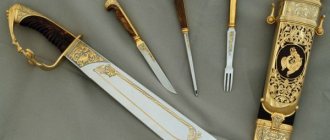- September 16, 2019
- Equipment
- Alexander Romanov
A knife is both a weapon and a tool. Which product is only a tool, and which knife is a bladed weapon, is sometimes extremely difficult to figure out. The very fact of this division in our country is quite curious, and it is not at all based on prohibitions and restrictions on freedoms, as many sometimes think. First of all, there are two aspects to the term “edged weapon”. One of them is constructive. The other is legal, or juridical. It needs to be considered first.
Legal aspect
Here the main role is not played by which knife is considered a bladed weapon and which is not. Moreover, in this aspect it may not even be a knife at all, since the legal interpretation of edged weapons only presupposes the capacity in which a particular item was used. And if the item was used as a weapon, then in the eyes of the law it will be such. This aspect concerns one specific subject within one specific action. And since a variety of objects can be used as edged weapons, understanding this interpretation is very important.
Folding or regular?
Another important question is whether to choose folding knives or regular ones. Preference should be given to the first. On the one hand, they are compact - if they are well designed, they will not open spontaneously and will not cause injuries.
On the other hand, they can be carried in a pocket, while one fixed on a belt will attract unnecessary attention and take up too much space in the pocket. Finally, for some reason, law enforcement officers are much calmer about folding knives than simple ones.
At the same time, such a knife copes well with the main functions - you can’t cut up a pig with it, but you can cut sausage, open a can of stew, or sharpen a pencil with it.
Constructive aspect
Each knife has a specific purpose. Some knives are designed for kitchen work, others for cutting game, others for heavy work, and so on. Knives that are considered edged weapons include one additional task in their range of tasks - the ability to effectively hit a living target with maximum convenience and safety for the knife user. In Russian legislation, there are state standards (GOSTs) that impose certain requirements on knives for one purpose or another. There are similar requirements for knives that act as edged weapons. All of them are stated in a document called “GOST R 51215-98. The weapon is cold. Terms and Definitions". This standard was created not only for knives, but also for other types of bladed weapons, including long-bladed weapons (swords, broadswords and sabers), impact weapons (clubs, flails), polearms (spears and halberds) and even throwing weapons (bows and crossbows).
So, what is a bladed weapon and what kind of knife is it? Looking into the interpretation of GOST, we get a very clear answer: this is “a weapon structurally designed to hit a target using human muscular power.” It's that simple. “Structurally intended” means exactly what we talked about above. That is, such an ability must initially be built into the design of the knife.
It is important! The expression “hitting a target” in the context of knives means precisely hitting a target, that is, the most simple, sharp and intuitive action that causes the most severe damage to the target. The possibility of repeated repetition of this action is often noted, ensuring the utmost reliability of the lesion.
The above GOST gives general compliance characteristics:
Is it possible to carry a knife in the city?
Usually in rural areas, carrying a knife is not prohibited, but in urban areas things are completely different. The law does not prohibit carrying several types of knives, from pocket knives to kukris.
But law enforcement officials have a negative attitude towards carrying knives. Just by the sight of a knife, police officers will have a lot of questions. It is better for the owner of the knife to confidently answer that this is not a bladed weapon, since the blade is too short and there is no limiter on it. Often, law enforcement officers do not simply pester respectable and adequate citizens with demands to show them a passport, much less with a search.
If, nevertheless, you are stopped and asked a typical question: “Do you have a weapon with you?” You should answer that there are no weapons, but there are piercing and cutting objects and present a knife. The employee may also ask why you are carrying a knife with you.
In what cases can a knife come in handy on the city streets?
It is clear that a law enforcement representative can be told many ways in which a knife can be used on city streets. Let's consider the real purpose of the knife:
- if you get into an accident, a knife will help get rid of jammed seat belts; you need to cut them with a knife;
- if the door handle breaks, you can pry the tongue with a knife and squeeze it out;
- you can pry up the window bead and go into the room if the door in your house is jammed;
- the knife can be used for shaving, for example, if you go on vacation with tents;
- using a knife you can sharpen pencils or make a baton from a tree branch;
- You can use a knife to tighten a screw that has come out, for example, on sunglasses;
- a knife can cut a rope or thread;
- using a knife you can open the cap of a bottle of lemonade or a tin can;
- You can also cut food if you want to eat right on the street.
After all, a knife can be used for self-defense. This does not mean that it should be used against a person. Just the sight of a knife can scare away a bully. It is also possible that dogs will attack, in which a knife will again help defend.
How should you carry a knife on the city streets?
Of all types of knives, folding knives are the most convenient to carry. It is better not to carry knives that have an impressive weight in your pocket, there is a risk of losing them. For those who prefer fixed blade knives, it is better to use various concealed carry systems. The knife can be attached to the forearm, put in a deep inner pocket, or purchase a body bag and carry the knife in it.
Remember, any knife, even if it is not a bladed weapon, can easily turn into a crime weapon, and this means time and prison.
Appendix B (for reference). Signs on the basis of which products are classified as edged weapons
Appendix B (for reference)
B.1 The presence of structural elements in the product with a tip and (or) one (two) blade (blades) and (or) concentrated mass and a hard surface.
B.2 Compliance of the weight and overall dimensions of the product with the physical capabilities of a person, which allows them to wear these products and operate them manually.
B.3 Sufficient human muscular energy to effectively defeat a living target with a single use of the product.
B.4 Lack of a direct and convenient way to use the product to perform household or industrial work.
B.5 The presence of structural elements that facilitate the use of the product to hit a target and interfere with the performance of household or industrial work.
B.6 The product has strength and reliability that is excessive for its use as a tool when performing household work.
(c) GOST R 51215-98. The weapon is cold. Terms and Definitions
As we see, these signs are very general and do not answer the main question: how to determine which knife is considered a bladed weapon? Other documents will answer this question, namely: GOST R 51500-99 “Hunting knives and daggers” and GOST R 51548-2000 “Survival knives”. Why them? For the reason that civilian edged weapons (that is, those knives that are legally available to ordinary citizens of the Russian Federation) include only hunting knives and daggers, as well as survival knives. It is these types of knives that structurally include the function of hitting a living target. And now in these documents, all the necessary characteristics are clearly spelled out in millimeters and measurement methods. Without going into the too dry and sophisticated language of the legislation, we will try to group these signs below.
Which knife is a weapon, and which one is a household item?
In addition to the “general” GOST, there are also special ones that describe different knives:
- for tourists and athletes (R 51501-99);
- for cutting carcasses and skinning (P 51644-2000);
- for hunting (P 51500-99);
- for survival (P 51548-2000).
It is not necessary to read them at all - it is enough to take a certificate for it when buying a knife. It is also called an information sheet, and it contains a photograph, characteristics of the knife and its purpose. It will definitely indicate that this is not a bladed weapon, but, for example, a household item or a knife for tourists. You should take the paper with you along with a knife to make your life easier if the police have questions for you.
5 parameters of a knife weapon
If you nevertheless study the documents, you can identify the signs that make a knife a weapon:
- The blade is longer than 90 mm.
- The hardness of steel is from 42 units on a special scale.
- The butt thickness is from 2.6 to 6 mm.
- There is a limiter on the handle, and if there are grooves for fingers, they are no smaller than 4 mm. This makes the handle injury-proof for the person holding the knife.
- The blade is sharpened.
You cannot measure the hardness of the blade yourself; it must be looked at in the certificate. And you can sharpen it if you wish: the blade is considered sharp if it cuts a birch branch about 1.2 cm thick - cleanly and six times in a row.
For a knife to be recognized as a bladed weapon, it must have all 5 parameters.
Knife handle
This is a fairly broad requirement. First of all, the handle should ensure the owner’s safety from injury when using the knife, that is, eliminate the possibility of the hand slipping onto the blade during a strong stabbing blow. To do this, there are either stops or finger grooves on the handle of the knife. The length of the one-sided stop (limiter), or the total length of the two-sided one, should not be less than 5 mm. The same applies to the depth of the finger groove, if it is present alone on the handle. If there are several such recesses, then the depth of each of them should not be less than 4 mm. Accordingly, if a knife has a simple handle, without stops or recesses, it cannot provide adequate safety for the hand and will not be a bladed weapon.
The above requirements are valid only for those stops and guards that are formed by a separate transverse plate and represent an independent structural element. However, there are handles where the stops are formed by the so-called heel of the blade, that is, the same metal that forms the blade itself. This is often found on slip-mount knives, where the handle and blade are made from one solid piece, with pads on the sides for easy grip. In this case, the length of the supports for edged weapons is still 5 mm, but the thickness of the metal outgrowths themselves should not be less than 3.5 mm to ensure comfort and safety of holding.
Restrictions by law
In Russia, restrictions have been imposed on a number of weapons that pose a danger to humans. In some cases, the law prohibits the purchase or use of them, even if the person has a permit to carry and possess dangerous items.
These prohibitions apply equally to civilians and government employees. Such weapons include:
- Boomerangs, shurikens, brass knuckles, which are currently no longer items of defense. With the exception of the throwing ball, this category can also include all throwing, piercing, slashing and impact-crushing weapons.
- Store and use knives that are manufactured with automatic blade extraction, the length of which should be more than 9 cm.
In Russia, the law regulates the sending of military, military or sporting weapons by mail. It is strictly prohibited to bring such dangerous objects with you to rallies or various meetings and demonstrations.
Knife blade shape
To ensure guaranteed reliability of penetration into the target (and removal from it), the knife blade must meet not only mechanical, but also geometric compliance and standards. First of all, it must be straight, with a pronounced tip. No upward bends, no sharpened tip, or any hooks on the blade are allowed. In concrete terms this is expressed as follows:
- The tip of the knife should not rise above the common spine line by more than 5 mm. This parameter is exceptional, that is, if the tip is raised at least by the specified amount, the knife is no longer considered cold.
- A downward tip is also unacceptable. This tip is found on skinning and heavy chopping knives that have a general outline in the form of a rocker arm, with a pronounced back curved upward. In this case, the measurement is made by drawing an imaginary line from the tip of the knife to the end of its handle. If the distance between this line and the back of the knife is 15 millimeters or more, then by law such a knife will be a cutting knife and removed from the category of edged weapons.
- Deflections in the butt of the knife, which change the overall straight appearance of the blade, are also unacceptable. The amount of such deflection is allowed up to 5 mm exclusively, as is the case with the tip raised above the butt line.
- The severity of the tip is determined by a clear number. The angle of its convergence formed by the butt and the blade should not be more than 70 degrees to ensure ease of penetration with a thrust.
- It is also not allowed to replace (sharpen) the tip with a tool, such as a slotted screwdriver.
- On some hunting knives you can see a special hook designed for skinning prey. Its presence in the same way excludes the knife from being a bladed weapon, since it does not ensure multiple hits of the target with a thrust.
Signs of edged weapons and parameters: 5 main components
The signs of a real edged weapon are all its physical parameters considered together, that is, the overall size, the length of the blade and handle, the thickness of the blunt edge of the main part, the quality of the steel, and the features of the handle from the point of view of convenience and safety. They are specified in GOST, as well as federal law, and the requirements apply to both factory-made and handicraft products. 5 signs of edged weapons are:
| Parameter | Its meaning or presence |
| Blade length | More than 9 cm |
| Butt thickness | 2.5-6 mm |
| Hardness of the steel from which the blade is made | From 42 HRC |
| Recesses on the handle for a comfortable grip | Depth from 4 mm |
| One notch on the handle or finger stop | Depth from 5 mm |
| Sharpened Blade | Eat |
It is possible to establish that a knife has non-domestic use, is not a sports equipment or a production device, if all the above conditions are simultaneously present. But sometimes it is possible to identify edged weapons only after an examination. And when doing this, the sharpness of the blade, for example, is very controversial, because it can be recognized as sharpened even if it only cuts paper.
In general, among all the components, the most important thing is the features of the blade. A product cannot be considered a weapon if it has:
- The tip is rounded or designed for performing household work (such as a screwdriver). It is difficult for them to stab, so the knife is not recognized as a bladed weapon.
- The tip is 5 mm above the butt line. In these cases, stabbing is also problematic.
- The butt has a deflection of 5 mm, and the length is up to 180 mm. Or the first indicator is 10 mm, and the second is from 180 mm. And here the thrusting blow is poorly executed.
- There is a hook at a distance of 1/3 of the length of the blade from the tip. This happens with hunting knives that are not edged weapons.
- The butt and the part of the handle closest to the blade are curved upward by more than 15 mm. And this prevents the knife from being stabbed.
- The lines of the blade and butt form an angle of more than 70 degrees. This also makes it difficult to thrust.
- The handle is less than 70 mm, it has grooves up to 4 mm deep or there are none at all, as well as a limiter. With such initial data, the knife is dangerous for the piercer, that is, it is not intended to kill.
Blade length, thickness
The length of the knife blade, which is a weapon of destruction, is more than 9 cm. It should be measured from the tip to the point of connection with the handle or limiter. But many kitchen products have this length; nevertheless, they are allowed and sold freely. That is, this value in itself is not yet a sign of a prohibited weapon; for example, the thickness of the blade also matters. This is the sharpness of the blade and butt, which will be discussed further.
Blade length
The length of the blade of a knife that is prohibited from being owned without a license is not regulated by GOST. When they mention it, they mean the size of the blade, although this is not exactly the same thing:
- it is measured from the tip of the tip to the beginning of the handle (for edged weapons more than 9 cm);
- The size of the blade is determined by the sharpened edge of the blade.
But to determine the type of weapon, the parameter does not matter.
Butt thickness
The thickness of the butt, which is prohibited for free purchase of the product, is 2.6-6 mm in the most massive part. If it is less than the minimum value, it is considered that the blade will bend upon impact. And with a thickness of 6 mm or more, sticking it into the body is also problematic, that is, the penetrating ability is lower. Although in fact both statements are controversial. And yet, approved knives usually have a spine no more than 2.4 mm thick.
Confinement
The sharpness of the blade of the cold tool is such that it should be able to cut a birch branch with a thickness of 10-12 mm and 12% humidity in 5 movements. Moreover, the surface of the exposed area of the stick should be smooth, without “burrs.” This condition is specified in GOST.
Anatomy of a blade: a clear understanding of what descents, approaches and cutting edges are
Hardness
The blade steel of a melee weapon must be from 42 HRC. Anything less than this value will bend upon impact, meaning it will not be possible to fully strike with it. This criterion is also defined by the state standard.
Folding knives
Based on what was written above, it seems that only knives with a fixed blade are edged weapons. However, many people also use folding knives when hunting. Can a folding knife be considered a bladed weapon in Russia and what kind of knife will it be? Yes maybe. Hunting knives, that is, civilian bladed weapons, may include folding knives, the blade of which is not completely retracted into the handle when folded, provided that its length is at least 150 mm, and all the necessary requirements for the safety of the handle in such a knife are met. .
Such knives will require a special sheath to carry them, and they fold not for the purpose of safely storing the blade, but simply to save space. Any other folding knife, regardless of design, if the length of its blade does not exceed 150 mm, and the blade is completely retracted into the handle, by definition does not belong to a bladed weapon.
Classification of edged weapons
The classification of different types of edged weapons can be:
- For the intended purpose. Products can be civilian, that is, used to perform some kind of work, or combat. The first type includes sports, hunting tools, and also those that are part of national clothing.
- According to the manufacturing method. Products can be factory-made, artisanal, homemade or redesigned. The first two types differ in compliance with standards. Homemade is done by non-specialists, unlike artisanal. And the converted one lacks required elements or new ones can be added.
- According to the principle of operation. These are piercing, cutting, chopping, crushing, piercing-cutting (combined) instruments. With this classification, the criteria for edged weapons are sometimes quite vague. After all, with the same tool you can prick, cut, and chop.
- By type of impact. It can be bladed or thrown. The first involves direct contact with the enemy when causing damage. Throwing weapons for the same purpose are thrown from a certain distance.
- According to design features. Products are available with one or two blades.
The characteristics of edged weapons, even within the same type, may differ. For example, throwing a knife and a spear are considered sports. But there is an obvious difference between them.
What does cold stabbing refer to?
Specialists consider the following types of cold stabbing weapons:
- knife,
- dirk,
- pike,
- kris (national type of dagger with a curved shape),
- a spear,
- konchar (ancient Russian tetrahedral blade),
- stylet,
- bayonet,
- spear,
- rapier,
- sarissa (long spear).
Any of these instruments is designed to deliver piercing blows rather than cutting or slashing. To recognize a weapon as cold, the same characteristics must be present as when assessing another type.
Daggers
If the situation with knives is quite complicated, and it is sometimes difficult to understand which knife should correspond to what, then with daggers the situation is much clearer.
The very essence of the dagger suggests its use as a bladed weapon; it is intended exclusively for piercing blows and is practically unsuitable when used as a household tool. Of course, we may be told that real warriors in the old days could use a dagger to cut bread, kill an enemy, or kill an animal, but we admit the obvious fact: a dagger is a weapon. Unlike a knife, which has a spine and sometimes only partial sharpening on the second side of the blade, a dagger has both edges sharp. This both makes it easier to orient the blade in the hand in extreme situations and reduces resistance when the blade penetrates the target. In Russian legislation, daggers can be both hunting and combat; Occasionally, knives classified as “survival knives” are also allowed to have a dagger blade. All these products are clearly certified as edged weapons. The only exception for a dagger may be the length of the blade: if it does not exceed 89 mm, then such a dagger will not be “cold”.
Measurement and description of bladed weapons
In bladed weapons they are measured
:
- total length;
- blade length;
- maximum blade width;
- greatest blade thickness;
- length of the butt bevel (along the chord);
- the length and width of each lobe (if any);
- heel length; blade sharpening width; handle length;
- the width of the handle in the middle part or the greatest;
- maximum thickness of the handle;
- length and thickness of the pommel and bushings;
- length, width and thickness of the stop (limiter).
Description
is done in the following sequence:
a) general characteristics: the name of the object (and if the investigator finds it difficult to name it correctly, it is indicated as an “object”, what it consists of, the total length;
b) characteristics of the blade: shape, size, color, magnetic properties, number of blades, presence of a butt and its shape (straight, convex, concave, tortuous, stepped), presence of a bevel of the butt and its shape; location, shape and size of the dol; placement and content of markings, etc.
c) method of fastening the blade and handle (mounted, flat):
d) characteristics of the handle: overall shape and dimensions; what parts and components does it consist of; color, shape, size, material and magnetic properties of individual parts; nature of the surface; presence, location and content of markings;
e) characteristics of the stop (limiter): shape, dimensions, material, etc.;
f) lack of parts, breakdowns and other defects.
When described, edged weapons with a single-edged blade are oriented as follows: - in a horizontal position - with the blade down and the pommel towards you. - in a vertical position - with the tip down and the blade towards you (accordingly, it will have left and right sides).
If the blade is double-edged or has several edges, orientation is carried out according to the shape of the handle or stop. You can also orient yourself by the location of the markings, which are usually applied on the left side from the tip to the handle, and on the right side, on the contrary, from the handle to the tip; or there are only sleeps on the left side. In addition, the transverse inscriptions on the heel of the blade go from bottom to top on the left side, and from top to bottom on the right side.
Large knives and cleavers
Often, when you encounter a large knife in a person’s hands, you can hear exclamations about edged weapons. Is the size of the knife an important factor and which knives should be classified as edged weapons in this case? This is not exactly a case where size matters. As we already know, the length of the blade in edged weapons is not so important - all blades longer than 9 centimeters can meet the required characteristics. However, in the legislation there is such a thing as “hunting cleavers”. These are large knives with a blade length from 150 mm to half a meter; all of them must have a point that provides comfortable and effective piercing blows. These knives are also equipped with impressive crosses, stops or guards. For them, unlike conventional knives, a blade hardness of 40 units is allowed. HRc. These cleavers are used both for finishing off animals and defending against animal attacks, and for performing economic tasks during the hunt, and strict requirements for them are quite natural.
Types of bladed weapons
There are the following types of the most common edged weapons:
- chopping (axes of various types);
- sports (knives, rapiers, swords, etc.);
- hunting (horns, knives, cutlasses, stilettos, etc.);
- combat (bayonet-knives, daggers, etc.).
Slashing
A chopping weapon that falls under Federal Law No. 150-FZ of 1996 is any type of battle ax:
- bearded,
- labrys,
- tomahawk,
- berdysh,
- valashka,
- minted
This category also includes cutting and piercing cleaver, saber, broadsword, saber, dagger, axe, and sword. As well as the less common halberd, machete, kukri, scimitar. Any type of product must have a sharpened blade, otherwise it can be legally owned without a license and without fear of a fine. Collectors, those involved in military reenactments, may own any of these types of weapons, as long as the blade is dull.
Sports
Sporting weapons prohibited in the public domain are:
- sword,
- a spear,
- rapier,
- saber,
- sword,
- throwing knives.
We are talking about specimens that have the characteristics inherent in bladed weapons. For example, swords and rapiers that athletes use in training and competitions are not such. Like throwing knives sold in stores, their blade is not sharpened; only the upper third of the blade remains sharp.
Hunting
A hunting weapon is considered cold if it is:
- dagger,
- stylet,
- cleaver,
- spear,
- a spear,
- knife.
But only when they have a blade length of 90 mm, the blade is sharpened (especially on both sides), the handle is 70 mm in size and protects against injury during a piercing blow, thickness butt is more than 2.6 mm, but less than 6 mm.
Combat
Military weapons are divided into:
- made for military and paramilitary forces (knives, bayonets, daggers);
- police officers (these include not only instruments with blades, but also batons and tonfa);
- civilian (which is part of the national costume, for example, among Caucasians and northern peoples).
All of the above can be classified as cold steel if the previously mentioned signs are present. In the absence of at least one of them, the examination recognizes the item as authorized for possession and wearing. For example, if the knife looks like a military knife, but it has a dull blade, or it is less than 9 cm.
Combined
A combined weapon is something that combines several varieties:
- firearms and piercing objects (for example, rifles with bayonets);
- a multifunctional product that, in addition to the blade, contains a working tool;
- a weapon with a secret, when another is hidden in one object (a dagger in the handle of a mace or a pike in a sword).
The criteria for classification as a prohibited species are the same as in previous cases. But due to the complexity of the product design, they are not so obvious and sometimes assessment is difficult without an examination.
Rifle with bayonet
Machete
Despite their terrifying appearance, machetes, of course, are not melee weapons. Firstly, they do not have a pronounced point; secondly, the thickness of the blade does not provide rigidity and safety when piercing - often it does not exceed two millimeters. And even the ability to deliver the most dangerous cutting blows does not make such blades a weapon, since, according to legal requirements, edged weapons are intended primarily for piercing, and only then for all other tasks. According to GOST requirements, the blade length for such products starts from 175 mm and, like hunting cleavers, reaches half a meter.
Interesting edged weapons of the world
Noteworthy edged weapons in the world are:
- Russian combat knives Gyurza, Lynx, Punisher, Vityaz, Antiterror, Akela, Shaitan;
- foreign-made military products Ka Bar Next Generation Fighter, Eickhorn Kampfmesser 2000, Extrema Ratio Fulcrum S, etc.;
- tools of ancient times Santesu, Klinga, Chakram, Katar, Khopesh, Cho-ko-nu, Odati, etc.
Best Contemporary
The best modern edged weapons belong to the category of combat weapons, and among Russian ones these are knives:
| Knife name | Description | Photo |
| Lynx | Created in Zlatoust, having a dagger-shaped blade. | |
| chastener | Made by order of the special services, it has a serrated blade sharpening and a wide main part. | |
| Knight | With a massive and heavy, but not wide blade. | |
| Anti-terror | Characterized by a serrated edge of the butt and a sharp blade. | |
| Shaitan | With a leaf-shaped blade and double sharpening. | |
| Akela | With a narrow dagger-like main part and a sharp butt. | |
| Gyurza | Characterized by double sharpening and a jagged spine. | |
| Cobra | It has a narrow double-sided blade and therefore works well when delivering not only piercing, but also cutting blows. | |
| Werewolf | A folding knife that is both combat and survival, as it has a blade, 2 saws, a nail puller, an opener, and a screwdriver. |
Among the foreign-made guns, the best are:
- the American Ka Bar Next Generation Fighter, which has a wide blade with a one-sided sharpening;
- also an American Camillus Jet Pilots Survival Knife, designed not only for combat, but also for survival in difficult conditions;
- another American Ontario Mk.3 Mod.0 Navy Seal Knife, which can be used as a saw, hammer, but mainly for stabbing;
- German Eickhorn Kampfmesser 2000, distinguished by a unique blade shape, similar to Japanese knives, as well as large slopes, serrated sharpening on a third of the blade;
- Italian Extrema Ratio Fulcrum S, which is convenient for stabbing, cutting and chopping thanks to a narrow but powerful double-sided serrated blade;
- CQD Mark V ATAC, which is a dagger with a 2/3 sharpened butt, which will also help for survival.
Watch the video about the 10 best knives of foreign origin:
Rare
Rare weapons classified as cold steel are mainly antique or national types of knives:
- Japanese Santesu, which is a double-edged lance with a ring handle attached to the center;
- Nubian Klinga, which has 3 blades;
- Indian Chakram - a throwing ring with a wavy handle in the middle;
- the Aztec Macuahutl, which is a wooden blade to which sharp glass was attached;
- Indian dagger Qatar with three blades fixed to an H-shaped handle;
- Egyptian Khopesh, which is a sickle with a wooden handle;
- The Chinese Cho-ko-nu is a wooden crossbow that works in such a way that you can load an arrow, pull the string and shoot in one motion.
Chinese Cho-ko-nu Indian knife Chakram Nubian knife Kling Egyptian sickle sword Khopesh
Among all the swords that deserve special attention: Japanese Naginata and Odachi, ancient Greek Xiphos, ancient Roman Gladius, Scythian Mitsiya, as well as ancient Russian ones.
Certification
According to the law, only an expert can identify all the signs and determine which knives are edged weapons and which are not. After evaluating a specific product or a sample of a batch of products, a certificate is issued for it or a factory batch - a conclusion from the ECC of the Ministry of Internal Affairs on the belonging of the products to a particular type of knives. Such certificates are also issued for edged weapons, as evidence that a particular knife fully complies with all the strict requirements of GOSTs. As an appendix to such a certificate, as a rule, there is an information sheet (IL), which contains a photograph of this knife, clearly describes all its characteristics, and also contains a conclusion on what basis the knife is (or is not) classified as a bladed weapon. These information sheets must be attached to each knife that is sold on the territory of the Russian Federation, so that both the user and law enforcement agencies can easily navigate the paperwork regarding the knife. And according to the law, the question of which knife is considered a cold weapon in Russia can only be answered by an expert opinion.
How to carry a bladed weapon
You can carry bladed weapons only if you have a license for it, which is obtained from the police. Ordinary citizens have access to the legal purchase of hunting blades, as well as products that are an attribute of the national costume (sabers, knives, checkers, daggers). Award weapons can also be owned, but not inherited, given away or sold.
It should be worn:
- be safe, that is, the product should be hidden in a case or sheath;
- be supplemented by the presence of a permit (hunting ticket with a mark, license), as well as the owner’s passport.
You cannot take tools with you to public events, cultural or political, if they are not related to the demonstration of products.
Pros and cons
So, are “cold” knives the most adequate option when choosing? Certainly not. The best knives that we can choose for ourselves will almost never be like this. The main criterion here is not only the scope of tasks, but also legal restrictions on the carrying and circulation of bladed weapons. If household knives have no restrictions on use and purchase, then in the case of edged weapons you should be careful. But then, secondly, we determine what the knife will be used for. And here sometimes compromises are impossible. For example, what knives should perform the function of finishing off an animal during a hunt leaves us with no choice but to turn to extremely effective edged weapons. And some restrictions on its free carrying or acquisition should not repel us, but once again remind us that handling weapons implies responsibility.
What is the penalty for selling, carrying and making such knives?
If a citizen illegally bought, manufactured or carries a bladed weapon, then he faces real liability:
- administrative penalties for carrying are provided for by the Code of Administrative Offenses;
- for production and sale the perpetrator will be punished under the Criminal Code.
If the knife does not fall under the category of bladed weapons, then the police will not be able to prosecute for it. If the blade is defined as a bladed weapon, then the owner must have permission to carry it. Lawyers also advise that even when purchasing an ordinary kitchen knife, you should play it safe and take a certificate from the seller indicating the household purpose of the product.
Is it possible to carry a knife with you and at what age?
Russian legislation imposes a number of prohibitions and restrictions on some types of weapons that are dangerous to people. The Criminal Code prohibits the use, purchase or sale of edged weapons, even if a citizen has permission to store and carry. Such restrictions apply equally to civil servants and civilians. The following are prohibited:
- brass knuckles;
- boomerangs;
- shurikens;
- all types of shock-crushing, throwing and chopping weapons;
- knives equipped with automatic blade ejection with a length greater than 90 mm.
As for carrying, edged weapons can only be carried with you if you have the appropriate permit/license for it, for which you contact the police. The civilian population is allowed to buy bladed hunting weapons or products related to the attributes of the national costume. You can also own a weapon from the award category, but it is strictly forbidden to give it as a gift, inherit it or sell it.
Carrying weapons is allowed only from the age of 18, since permission is issued only to adult citizens. Wherein:
- the knife must be in a sheath or case so that its wearing is safe for others and the owner himself;
- You must have a passport with you with permission to carry a knife.
It is strictly unacceptable to take potentially dangerous knives with you when going to public or mass enterprises, political or cultural meetings, etc. But in fact, on Russian territory you can carry any knife, even from the category of edged weapons. The whole point is in a specific situation, for example, carrying it home from the store, etc.
Therefore, such situations must be approached wisely. The National Guard or police can stop any citizen on the street. If you have a weapon with you, you need to carefully explain its purpose. It is better to give neutral answers, and categorically not specify that you are carrying a knife with you for personal self-defense. Otherwise, law enforcement officers may charge actions under Art. 6. gun laws that prohibit carrying them for self-defense.
Video on the topic:
Restriction of the use of bladed weapons in civilian circulation
The Weapons Law establishes that the following actions with edged weapons are prohibited on the territory of the Russian Federation:
- forwarding;
- wearing during street processions, rallies, demonstrations;
- wearing for self-defense, except in cases of transportation;
- storage and use of sports weapons outside sports facilities.
In addition, it is prohibited to have:
- bladed weapons that do not meet the requirements established by the legislator;
- weapons whose main purpose is impact, crushing or throwing action (for example, brass knuckles, boomerang).
Thus, carrying and storing knives, even illegal ones, are not criminal offenses. However, we recommend that you still obtain a license or permit to use a weapon.
What if there is no certificate?
Everything that was said above applies primarily to factory-made non-folding knives produced in the Russian Federation or officially imported from abroad. But what about various gifts from friends, “homemade goods” and foreign souvenirs carried in luggage? Everything is sad here.
On the same topic
Sharper than a razor: how to sharpen knives correctly
For such a product to be recognized as a weapon, it only needs to have a blade length of more than 90 mm, a thickness of more than 2.4 mm and a pronounced finger rest. If the examination gives a “cold” verdict, and you admit that you bought/received this knife as a gift, my condolences: you will still receive an “administrative certificate”.
For those in doubt, I recommend reading a rather interesting document.
What definitely won’t lead to problems with the law?
If you cannot do without such a useful tool as a knife, in everyday life give preference to folding models that comply with the domestic GOST R 51501‑99.
The requirements here are minimal: the circulation of automatic, spring, inertial - butterfly-type knives, and others whose design allows the blade to be removed with an accelerated movement - with a blade length of over 90 mm is prohibited. However, more is possible, but then the blade must have no point. With a safety handle, folding blades with a blade length of up to 150 mm are allowed; if the handle is traumatic, the length of the blade can reach 220 mm.
If you prefer “fixes”, I’ll warn you right away: use only models that are certified in the Russian Federation as tourist, cutting and household ones.
Punishment for illegal actions with bladed weapons:
| Sales and production of edged weapons | Criminal liability (Articles 222 and 223 of the Criminal Code of the Russian Federation), imprisonment for up to two years; |
| Carrying, transporting and storing | Administrative liability (Administrative Code, Article 20.8), a fine of 500 to 2000 rubles, or temporary restriction of the right to carry and store weapons; |
There is no liability in Russia for carrying, storing, selling and transporting knives that are not edged weapons.
“Cold!”
Imagine: another “boys’ get-together”, the conversation turns to knives. There will definitely be someone who knows more than everyone else. You remember that you have had a knife in your glove compartment for a long time, a gift from someone, and present it to the eyes of an honest company. The expert with an important look takes the knife and puts his palm to it - the tip sticks out slightly from the edge of the palm. “Cold man! — the expert drops majestically, “The cops will accept you, sure!”
“Oh-oh-oh,” you get scared, “how long have I been under arrest?!” We need to get rid of our favorite piece of hardware, what a pity...”
But what if this is not accurate?
On the same topic
From blade to awl: top 5 folding military knives
There are many home-grown experts on any burning topic in the world. They reinforce their “knowledge” with the use of “special terms” such as “bloodstock”, “pike”, “Zon’s fish”, “mercury blade”, “locomotive valve”, as well as chilling examples. And what’s most curious is that when it comes to “life stories” they are right.
True, the term “melee weapon” itself has now become a bogeyman. They pronounce it completely thoughtlessly, using it in relation to objects that, in comparison with the true coldness of the past, can only evoke a smile. In comparison with swords, halberds, pikes, misericords, bayonets, and so on, a tiny knife, for which you can get a real prison sentence (and not only in the USSR, but also in some modern “first world” states), looks ridiculous and pathetic.
And yet, relatively recently, getting a sentence under the article “carrying a bladed weapon” was quite simple...
